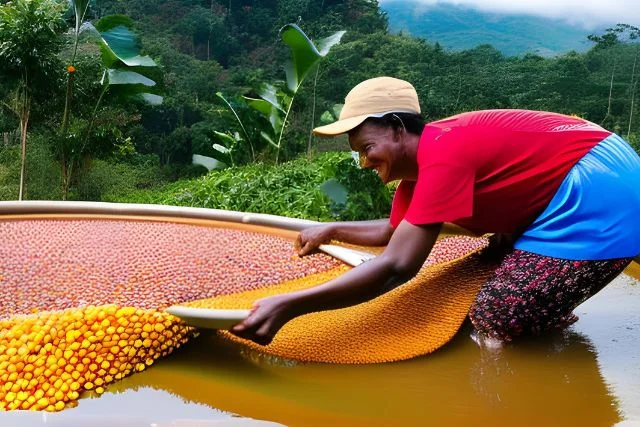Regenerative Agriculture in Coffee Farming
Coffee is one of the world’s most beloved beverages, yet the environmental impact of conventional coffee farming can be significant. An emerging alternative is regenerative agriculture coffee farming, a holistic approach that aims to restore soil health, enhance biodiversity, improve water cycles, and increase carbon sequestration on coffee farms. This article provides an overview of regenerative techniques and their benefits for producing sustainable, high-quality coffee.
Key Takeaways
- Regenerative Principles: Regenerative coffee farming focuses on soil health, biodiversity, water cycles, and carbon sequestration, adopting a holistic approach.
- Contrast with Conventional: It differs from conventional farming by promoting diversity, reducing chemicals, and prioritizing long-term sustainability over immediate profits.
- Benefits: Regenerative coffee farming offers higher-quality beans, improved soil health, reduced environmental impact, and economic resilience for farmers.
- Challenges and Potential: Transitioning faces challenges like costs and awareness but has the potential to become a dominant, sustainable model with support from the supply chain.

The Basics of Regenerative Agriculture
Regenerative agriculture is a system of farming principles and practices that focuses on topsoil regeneration, increasing biodiversity, improving the water cycle, enhancing ecosystem services, supporting biosequestration of carbon, increasing resilience to climate change, and strengthening the health and vitality of farming communities.
Here are some key differences between conventional and regenerative farming:
- Conventional farming often involves monocropping, heavy use of chemical fertilizers and pesticides, and tillage that can damage soil structure and degrade soil health over time. Regenerative farming embraces diversity through crop rotation, intercropping, and polyculture planting. It minimizes chemical inputs and avoids tilling to protect and enhance soil structure and long-term fertility.
- Conventional farming typically treats issues like pests, diseases, and soil fertility as isolated problems to be solved with specific solutions. Regenerative farming takes a whole-system approach to understanding the underlying, root causes of these issues and how they interact with the entire agroecosystem.
- Conventional farming aims to maximize yields and profitability from each harvest. While profitability is still important in regenerative farming, the priority is long-term soil health, biodiversity, ecosystem resilience, and community wellbeing over immediate yields.
- Conventional farming extracts resources from the soil without always replenishing them and disrupts natural ecosystems. Regenerative farming works to give back more than it takes using practices like composting and cover cropping to build soil health, intercropping and crop rotation to increase biodiversity, and integrating animals to cycle nutrients.
Overall, regenerative agriculture coffee farming takes a holistic view of the entire ecological landscape and farm organism and uses solutions that work in synergistic harmony with natural systems. It aims to create mutually beneficial relationships between plants, animals, insects, soils, water systems, farmers, and consumers.
Coffee Farming Challenges
Coffee is a permanent crop grown on over 27 million acres worldwide. Conventional coffee farming faces many interrelated challenges:
- Deforestation for coffee expansion removes native tree cover and can erode soils, reducing biodiversity and degrading the quality of the land over time.
- Heavy use of chemical pesticides and fertilizers can improve short-term yields but degrade long-term soil health, as these inputs damage soil biology and contaminate local waterways.
- Large-scale monoculture coffee plantations provide less diverse habitats than shade-grown polyculture systems, making the crops more vulnerable to climate change-related impacts like prolonged droughts, heavy rains, floods, and pest infestations.
- Commodity coffee prices are volatile, making it difficult for smallholder farmers to earn a stable income from season to season. This encourages expansion into marginal lands and cutting corners on environmental practices.
These complex, interrelated issues demonstrate the need for a whole-systems perspective and solutions. Regenerative agriculture coffee farming aims to holistically address these environmental, economic, and social challenges.

Regenerative Practices in Coffee Farming
Here are some of the core regenerative techniques that can be implemented on coffee farms:
Soil Health Improvement
Healthy soils provide the foundation for growing high-quality coffee plants and beans. Regenerative practices like cover cropping, reduced tillage, and compost application can dramatically improve soil structure, fertility, and biology:
- Cover crops like legumes are planted between the coffee rows to keep the soil covered. This reduces erosion, suppresses weeds, fixes nitrogen from the atmosphere, and increases organic matter. Common cover crop options include beans, peanuts, velvet bean, jackbean, and Desmodium.
- No-till or reduced tillage farming avoids plowing or digging up the entire soil surface. This protects beneficial fungi networks and soil structure. Strategic, occasional tillage may be used only when necessary.
- Compost and mulch add organic matter back into the soil, feeding soil microbes and important nutrients. This also enhances water retention during dry periods. Compost can be produced on-farm from coffee pulp, manure, food scraps, and crop residues.
Biodiversity and Ecosystem Restoration
Increasing above and below-ground biodiversity enhances the overall ecology and resilience of coffee farms:
- Shade-grown coffee mimics the natural forest ecosystem, supporting a diversity of birds, insects, and other wildlife that benefit the coffee through pollination, pest control, and nutrient cycling. Native tree species are ideal for shade cover.
- Habitat preservation and restoration provides ecosystem services like natural pest control from birds and bats that control harmful insect populations. Diverse beneficial insect populations can also be promoted through habitat for pollinators and predatory insects.
- Intercropping with compatible food crops like bananas, beans, peppers, squash and other fruits and vegetables diversifies income beyond just coffee. These associated crops also promote biodiversity and natural pest regulation.
Overall, these practices bring agricultural coffee production into greater harmony with surrounding natural ecosystems.

| Regenerative Practice | Environmental Benefit |
| Water harvesting earthworks like swales and berms | Improve rainfall capture and infiltration, reducing erosion and recharging groundwater |
| Riparian buffers of permanent native vegetation along waterways | Filter runoff, stabilize stream banks, and provide habitat |
| Windbreaks with multi-story agroforestry trees | Reduce wind erosion, provide shade and habitat, sequester carbon |
| Compost application | Enhances soil biology, nutrient availability, and moisture retention |
As illustrated in this table, many regenerative practices on coffee farms also provide ecosystem benefits like cleaner water, reduced erosion, enhanced pollination and pest control from biodiversity, and increased carbon sequestration both above and below ground.
Benefits of Regenerative Coffee Farming
Transitioning to regenerative agriculture techniques provides multiple benefits at various levels:
- The coffee beans produced under these practices are often higher quality and more flavorful compared to conventionally grown beans. Healthier soils and plants result in better taste.
- Enhanced soil health with more organic matter, biological activity, and available nutrients leads to potentially higher yields over time. Regenerative practices also increase resilience to climate extremes like drought.
- Sequestering atmospheric carbon into soils and trees can help mitigate climate change. More organic matter and active soil biology also retain more water in the landscape.
- Diversifying the farm ecosystem with associated crops, livestock integration, agroforestry, and off-farm income streams builds economic resilience and reduces dependence on coffee prices alone.
- Improved water quality, enhanced wildlife habitat, and restored ecosystems from regenerative coffee production provide benefits far beyond the farm boundaries to surrounding communities.
In summary, the benefits of regenerative coffee farming span from the soil microbes up through the plants, animals, farmers, and consumers. Sustainably raising coffee production requires scaling regenerative practices across the entire industry.

Case Studies
Here are two real-world examples that demonstrate the positive impacts of transitioning to regenerative techniques on coffee farms:
Capucas Coffee – Honduras
This family-run coffee farm operation converted from conventional intensive farming to a regenerative agroforestry model with native tree canopy layers and the use of cover crops like jack bean, velvet bean, and peanuts. Documented benefits included:
- 46% increase in soil organic matter content over 5 years; 70% increase in spring water sources and stream flows on the property
- Observation of over 40 new bird species and renewed wildlife activity as habitat was restored
- 30% increase in coffee yields over the 5 year transition period, likely due to the compounding benefits of soil health, biodiversity, and ecosystem restoration
Nespresso
Nespresso has been working with coffee farmers to implement regenerative farming practices, such as soil conservation and organic fertilization, to address the challenges of climate change, biodiversity loss, and community resilience. The benefits include a significant reduction in costs, an increase in productivity, and strengthened farmer income and land restoration .
- Increased coffee yields by up to 40% in some regions.
- Improved soil health by reducing soil erosion and increasing soil fertility.
- Increased biodiversity by providing habitats for birds and other animals.
- Reduced carbon footprint by sequestering carbon in trees and soil.
Biodiversal – Columbia
has implemented regenerative farming practices to improve soil health, increase biodiversity, and reduce the use of chemical fertilizers and pesticides. The farm recommends planting coffee-associated crops such as kidney beans and turmeric to enrich the soil and provide natural pest control.
- The farm has implemented regenerative farming practices to improve soil health, increase biodiversity, and reduce the use of chemical fertilizers and pesticides.
- The farm recommends planting coffee-associated crops such as kidney beans and turmeric to enrich the soil and provide natural pest control.
- The company’s new factory in Tolima, Colombia, produces biofertilizers such as biochar, a carbon residue from biomass sources.
These examples demonstrate how regenerative techniques can produce positive ecological and economic results on real coffee farms.

Challenges and Barriers to Adoption
However, some obstacles stand in the way of more widespread transition to regenerative practices:
- The upfront costs of changing farming methods and equipment can be prohibitive, especially for smallholder farmers without access to financing. It takes time to see the return on investment.
- Conventional monoculture methods are familiar, while regenerative systems require new technical knowledge. Capacity building through training programs is essential for farmer adoption.
- Transitioning requires patience and adaptive management as the farm ecosystem transforms. Some trial and error is involved in finding the right regenerative solutions for each unique context.
- Processing, distribution, and marketing infrastructure is geared toward commodity coffee. Different infrastructure may be needed to bring regeneratively grown specialty coffee to market.
- Currently there is limited consumer awareness of these practices and demand for verified regenerative coffee. Improved certifications and product marketing are important.
Targeted solutions like government cost-share programs, robust agricultural extension services, and upgraded coffee certifications and labeling can help overcome these barriers. But it requires commitment from all players in the supply chain.
The Future of Coffee Farming
Regenerative agriculture has an important role to play in the future of sustainable coffee production by:
- Regenerating degraded soils, enhancing biodiversity, and restoring supportive ecosystems to bolster long-term productivity.
- Providing ecological resilience to intensifying climate change impacts like rising temperatures, extreme rainfall, prolonged droughts, and pest outbreaks.
- Improving coffee farmer livelihoods through reduced input costs, diversified income streams, and secured land tenure or ownership of the coffee farms.
- Producing higher quality coffee with flavors that reflect the local environment or “terroir” – which commands price premiums.
- Sequestering atmospheric carbon into soils and biomass as part of nature-based climate change mitigation strategies.
With increasing consumer interest and climate pressures, regenerative coffee has the potential to scale rapidly and become the predominant model for the coffee industry. Proactive investment is needed to accelerate the transition.
How Individuals Can Support Regenerative Coffee Farming
You can help drive the expansion of regenerative practices as a consumer by:
- Purchasing coffees with credible regenerative certifications like Regenerative Organic Certified. This provides a marketplace incentive.
- Seeking out coffee shops and roasters that use verified sustainable, ethical beans and asking for transparency.
- Composting coffee grounds and food scraps to nourish your own home soil and garden. This helps complete the nutrient cycle.
- Supporting non-profits that provide training and resources to help coffee farmers transition to regenerative methods.
- Contacting coffee companies to request they integrate regenerative practices into their supply chains.
- Educating yourself and others on the importance of supporting sustainable coffee production.
Every dollar spent and action taken, even small ones, contributes to growing the regenerative coffee movement. Through collective consumer action, we can help turn the tide.

Conclusion
In conclusion, holistic regenerative practices can lead to substantial benefits for coffee farmers, local ecosystems, and consumers around the world. While challenges exist, the coffee industry has a unique opportunity to become a leader in the broader transition to regenerative agriculture. Conscientious consumer purchasing choices and vocal support for sustainability initiatives are powerful levers – so ask for regenerative! Together we can contribute to a brighter future for coffee producers and the environment.








